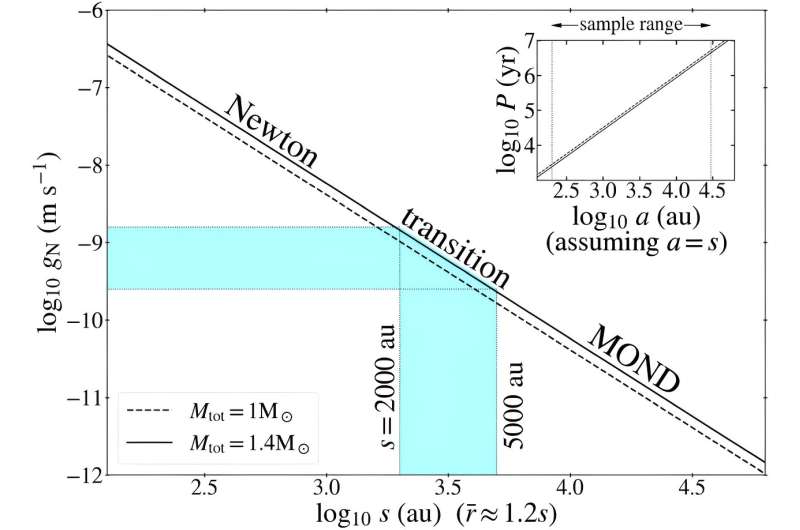
A new study published in The Astrophysical Journal reveals new evidence for standard gravity breaking down in an idiosyncratic manner at low acceleration. This new study reinforces the evidence for modified gravity that was previously reported in 2023 from an analysis of the orbital motions of gravitationally bound, widely separated (or long-period) binary stars, known as wide binaries.
The new study was carried out by Kyu-Hyun Chae, a professor of physics and astronomy at Sejong University in Seoul, South Korea, with wide binaries observed by European Space Agency’s Gaia space telescope.
Gravitational anomalies reported in 2023 by Chae’s study of wide binaries have the unique feature that orbital motions in binaries experience larger accelerations than Newtonian predictions when the mutual gravitational acceleration is weaker than about 1 nanometer per second squared and the acceleration boost factor becomes about 1.4 at accelerations lower than about 0.1 nanometer per second squared.
This elevated acceleration in wide binaries cannot be explained by invoking the undetected dark matter because the required dark matter density is out of the question based on galactic dynamics and cosmological observations.
Remarkably, the elevated acceleration agrees well with what MOND (modified Newtonian dynamics)-type modified gravity theories such as AQUAL predict under the external field effect of the Milky Way. The MOND paradigm was suggested by physicist Mordehai Milgrom and the AQUAL theory was formulated by him and the late physicist Jacob Bekenstein 40 years ago.
Because gravitationally-bound astrophysical systems such as galaxies and galaxy clusters and the universe itself are governed by gravity, the breakdown of standard gravity at low acceleration has profound implications for astrophysics and cosmology.
[…]
Chae conservatively selected up to 2,463 pure binaries, which are less than 10% of the sample used in the earlier study. Since the expected fraction of pure binaries among apparently binary systems is at least 50%, this much lower fraction means that the selection was sufficiently strict.
Chae applied two algorithms to test gravity from the sample of pure binaries. In one algorithm that was originally developed from the earlier work for general or “impure” samples, he used a Monte Carlo method to calculate (the probability distribution of) the observed kinematic acceleration, defined by relative velocity squared over the physical separation in the real three-dimensional space, as a function of the Newtonian gravitational acceleration between the two stars and then compared it with the corresponding Newtonian prediction of the kinematic acceleration.
In the other algorithm that is simpler and suitable for pure binaries, Chae compared the observed distribution of the sky-projected relative velocities between the two stars with respect to the sky-projected separations with the Newton-predicted distribution through a Monte Carlo method.
Both algorithms produce consistent results that agree well with the gravitational anomaly reported earlier.
[…]
However, the observed acceleration or relative velocity starts to deviate from the Newtonian prediction at a separation of about 2,000 au (astronomical units) and acceleration of about 1 nanometer per second squared. Then, there is a nearly constant boost of about 40 to 50% in acceleration or 20% boost in relative velocity at separation greater than about 5,000 au or acceleration lower than about 0.1 nanometer per second squared, up to the probed limit of about 20,000 au or 0.01 nanometer per second squared.
Chae’s new results agree well with an independent result by Xavier Hernandez’s group that is coincidentally in the production stage at present. This is significant because Hernandez’s group selected their sample completely independent of Chae’s selection and they used an independent algorithm (different from Chae’s two algorithms) based on the full distribution of relative velocities for their pure wide binary pairs.
[…]
Chae also points out that this new sample is explicitly free from any concerns of data quality cuts that have been raised in the literature so far. Chae further clarifies the recent contradicting claim by Indranil Banik and co-authors, saying, “Their methodology and results have a lot of problems. Their conclusion is invalid for two main reasons among others.”
“In their sample selection they knowingly excluded Newtonian-regime binaries that are crucial in accurately calibrating the occurrence rate of systems containing hidden additional component(s). Then, they employed a specific statistical algorithm of modeling velocities to infer gravity, the occurrence rate, and other parameters simultaneously, but ignored velocity errors though vital for their algorithm.”
Chae concludes, “At least three independent quantitative analyses by two independent groups reveal essentially the same gravitational anomaly. The gravitational anomaly is real, and a new scientific paradigm shift is on its way.”
The observed gravitational anomaly is remarkably well consistent with the MOND-type (Milgromian) gravity phenomenology. However, underlying theoretical possibilities encompassing the MOND-type gravity phenomenology are open at present, and this may be welcome news to theoretical physicists and mathematicians.
[…]
More information: Kyu-Hyun Chae, Robust Evidence for the Breakdown of Standard Gravity at Low Acceleration from Statistically Pure Binaries Free of Hidden Companions, The Astrophysical Journal (2024). DOI: 10.3847/1538-4357/ad0ed5
[…] few have looked at the effects on wildlife at the population level. Enter Erik Katovich, an economist at the University of Geneva. Dr Katovich made use of the Christmas Bird Count, a citizen-science project run by the National Audubon Society, an American non-profit outfit. Volunteers count birds they spot over Christmas, and the society compiles the numbers. Its records stretch back over a century.

 […] few have looked at the effects on wildlife at the population level. Enter Erik Katovich, an economist at the University of Geneva. Dr Katovich made use of the Christmas Bird Count, a citizen-science project run by the National Audubon Society, an American non-profit outfit. Volunteers count birds they spot over Christmas, and the society compiles the numbers. Its records stretch back over a century.
[…] few have looked at the effects on wildlife at the population level. Enter Erik Katovich, an economist at the University of Geneva. Dr Katovich made use of the Christmas Bird Count, a citizen-science project run by the National Audubon Society, an American non-profit outfit. Volunteers count birds they spot over Christmas, and the society compiles the numbers. Its records stretch back over a century.